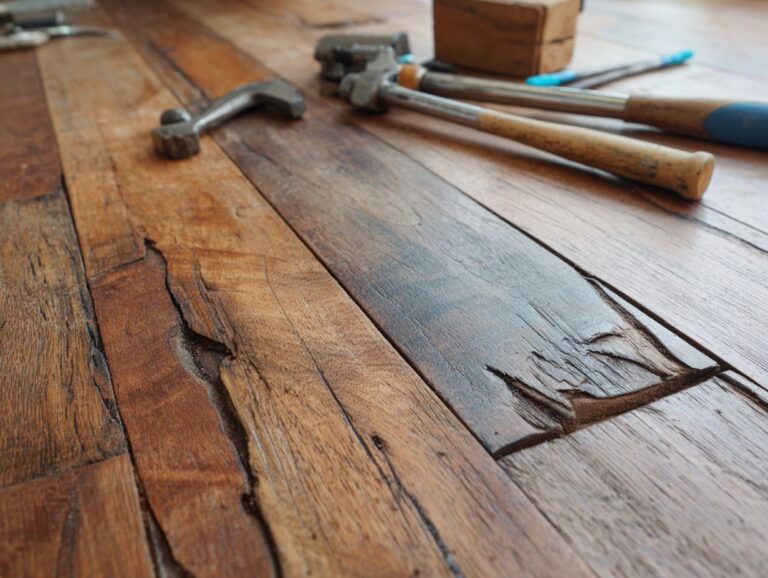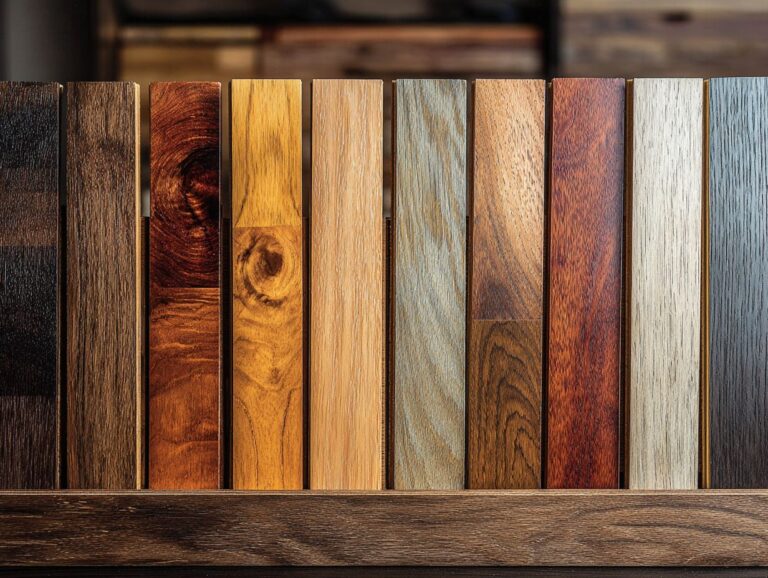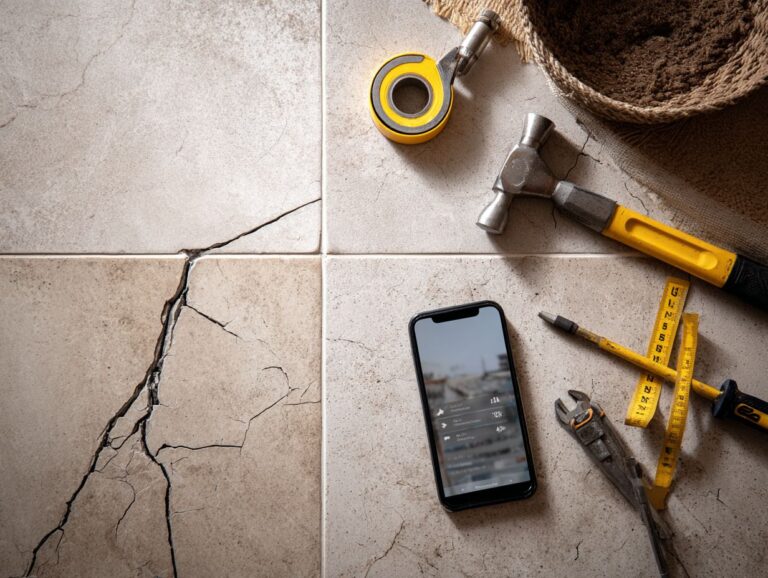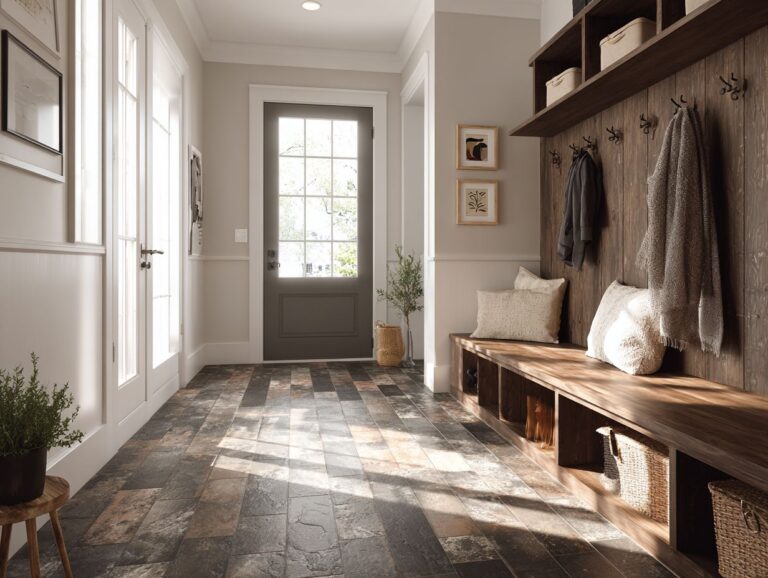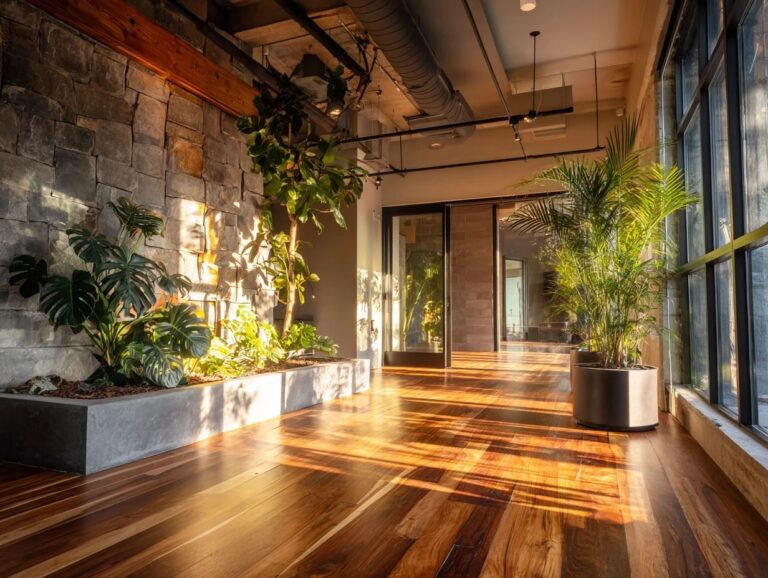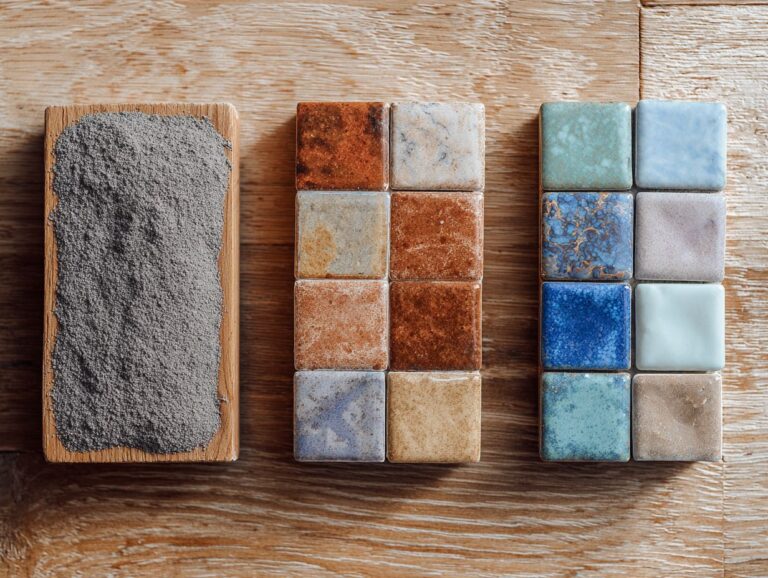Screen and Recoat vs Full Sand and Refinish
Knowing the difference between screen and recoat versus full sand and refinish is important for keeping hardwood floors in good condition. Southern Oaks Flooring, led by specialist Kristin Fitzgerald in Lynnwood, shares important knowledge about these methods. While screen and recoat effectively addresses superficial scratches with a fresh layer of polyurethane finish, sanding and refinishing provides a complete overhaul. This article will guide you through each process, helping you choose the best option for your flooring needs.
Key Takeaways:
Contents
- Comparison Overview
- Screen and Recoat Process
- Full Sand and Refinish Process
- Cost Comparison
- Durability and Longevity
- Environmental Impact
- Floor Refinishing Services Market Overview
- Frequently Asked Questions
- What is the difference between a screen and recoat and a full sand and refinish?
- Which option is more cost-effective, a screen and recoat or a full sand and refinish?
- Can a screen and recoat fix deep scratches and stains on a floor?
- How often should a screen and recoat or a full sand and refinish be done?
- Will a screen and recoat or a full sand and refinish change the color of my floor?
- Can I walk on my floor immediately after a screen and recoat or a full sand and refinish?
Definition of Screen and Recoat
Screen and recoat is a cost-effective option that refreshes hardwood floors by removing superficial scratches and applying a new protective layer of finish.
This process usually includes polishing the current finish to make the surface smooth and improve the stickiness of the new coat. By using a professional-grade buffer, you can effectively eliminate minor imperfections without the dust and mess associated with sanding.
After polishing, using a good polyurethane finish will bring back the shine and safeguard your floors from wear over time. To maintain the appearance of your hardwood floors, plan to use this service every 3-5 years based on how often the floors are walked on and their condition.
Definition of Full Sand and Refinish
Full sand and refinish involves sanding the hardwood floors down to bare wood, allowing for a complete rejuvenation of the floor’s appearance and repair of deep gouges.
This method typically requires five key steps.
- Begin by thoroughly cleaning the floor to remove dirt and debris.
- Next, use a drum sander to strip the existing finish, starting with coarse grit sandpaper and progressing to finer grits for a smooth surface.
- After sanding, vacuum away dust and apply a stain if desired.
- Apply a top-grade polyurethane coat to the wood to shield it from damage later on.
This method improves how your hardwood floors look and also helps them last longer.
Comparison Overview
Looking at the differences between screen and recoat versus full sanding and refinishing helps homeowners choose the right method for their hardwood floors based on their floor’s condition and their budget.
Purpose of Each Method
Screen and recoat is primarily for routine maintenance, while full sand and refinish serves as a solution for significant wear or aesthetic changes.
Screen and recoat means sanding the surface gently and putting on a new finish. This is ideal for floors that just need a touch-up and don’t have serious damage. This process usually takes a few hours and extends the life of finishes, preserving the underlying wood.
Conversely, a full sand and refinish strips away the old finish, addressing deep scratches or discoloration. While this is more labor-intensive and can take a couple of days, it rejuvenates worn floors to look brand new.
Consider the level of wear on your floor to choose the best method.
When to Use Each Method
Use screen and recoat for normal wear and tear, while full sand and refinish is best suited for floors with deep scratches or extensive damage.
Screening and recoating involves lightly sanding the surface to scuff it up and preparing it for a fresh coat of finish. This process is ideal for wood floors showing minor wear from foot traffic, typically requiring only a few hours of work and minimal cost.
A full sanding and refinishing removes the old finish and scratches, making it the best choice for floors with significant damage. Although this technique may require a week to finish, it restores the wood to its original beauty, providing a worthwhile investment for long-term looks.
Screen and Recoat Process
The screen and recoat process includes important preparation and application steps to achieve a perfect finish on hardwood floors.
Preparation Steps
To get ready for a screen and recoat, make sure the floor is completely clean, and check that the new finish sticks well.
- Start by removing any dust and debris using a vacuum or mop.
- For effective cleaning, use Bona Hardwood Floor Cleaner, which is gentle yet powerful enough to lift grime without damaging the surface.
- Next, inspect the floor for any gouges or scratches; repair these with wood filler if necessary.
- After cleaning, check if the new finish sticks well by putting a small amount on a hidden spot.
- If it adheres well after 24 hours, proceed with the recoating. This preparation leads to a perfect result.
Application Techniques
Using a buffing machine and applying a new polyurethane finish are important steps in the screen and recoat process.
- Begin by selecting a high-quality buffing machine, such as the Makita 9237CX3, known for its stability and ease of use.
- Apply 3M buffing pads with varying grits to achieve a smooth surface; start with a coarser pad to eliminate imperfections, then switch to a finer pad for polishing.
- Once buffing is complete, prepare a polyurethane finish by ensuring the area is well-ventilated and free of dust.
- Use a synthetic pad roller for a consistent application, allowing each coat to dry thoroughly before adding additional layers.
Drying and Curing Times
Once applied, a polyurethane finish dries in 2 to 6 hours and fully hardens in about 30 days.
To manage traffic and activities on the floor during these periods, consider these guidelines:
- First, avoid foot traffic for at least 24 hours to prevent imprints on the soft finish.
- Next, set up temporary barriers or signage around the treated area.
- For maximum airflow, leave windows and doors open for the initial 8 hours if weather permits.
- Keep pets and heavy furniture away for the entire curing period, ensuring a smooth, durable finish.
Full Sand and Refinish Process
Restoring the hardwood floor involves a thorough sanding and refinishing process with several steps to bring back its original look.
Preparation Steps
Effective preparation for full sanding includes removing furniture, cleaning the area, and ensuring proper ventilation.
To prepare your space for refinishing, follow these steps:
- Remove all furniture and anything else blocking the space to make it safe to work.
- Thoroughly clean the floor to remove dust and debris, which can interfere with the sanding process.
- Open windows for proper ventilation; this helps with dust control and keeps fresh air flowing while you work.
- Use drop cloths to protect baseboards and adjacent floors from dust and damage.
- Collect your equipment, like sanders, dust masks, and safety goggles, to make sure you’re all set before you begin.
Sanding Techniques
To get a smooth finish, it’s important to use the correct sanding methods, like starting with a drum sander and then using an edge sander.
Start by employing a Clarke Drum Sander with 80-grit paper to effectively remove any old finish or imperfections. Move in the direction of the wood grain, ensuring an even pressure to avoid gouging.
After using the drum sander, change to an edge sander or a detail sander with 120-grit paper to smooth the edges and corners, which the drum sander might not reach.
Finish with a hand sander using 220-grit paper for a smooth surface that’s ready for staining or sealing.
Staining and Finishing Options
Choose from various staining and finishing options, including water-based or oil-based polyurethane, to achieve your desired floor color and durability.
Water-based polyurethanes like Bona Traffic HD dry quickly and have a milder smell, making them ideal for indoor projects. In contrast, oil-based options like Minwax Polycrylic provide a richer color and added durability but take longer to cure.
Pallmann Magic Oil is another excellent choice, offering a natural look with a matte finish that highlights the wood grain. Consider your specific project needs, such as drying time and desired finish appearance, to select the best product for your floors.
Cost Comparison
Looking at the costs of screen and recoat compared to full sanding and refinishing helps homeowners budget for hardwood floor upkeep.
Material Costs
Material costs for screen and recoat typically range from $0.50 to $1.50 per square foot, while full sand and refinish can exceed $2.50 per square foot.
When budgeting for floor refinishing, consider additional factors that influence total costs. For instance, the type of finish used can add $0.25 to $0.75 per square foot, depending on whether you choose water-based or oil-based options.
Labor costs also vary, typically between $1.00 and $2.00 per square foot. It’s wise to obtain multiple estimates from local contractors while factoring in the condition of your floors, which could necessitate more extensive repairs, thereby increasing overall expenses.
Always request a breakdown of these costs for clarity.
Labor Costs
Labor costs can significantly impact overall expenses, with professional screen and recoats costing between $2 to $4 per square foot compared to $4 to $7 for a full sand and refinish.
In urban areas, labor tends to be on the higher end of these estimates due to cost of living. For example, in New York City, you might see charges of $5 to $8 per square foot for a complete sand and refinish, while a simple screen and recoat may still remain around $3 to $5.
Conversely, in smaller towns, you could find rates dropping to as low as $2 for screenings. When budgeting for a project, always inquire about regional differences and request detailed quotes from multiple contractors to find the best fit for your needs.
Durability and Longevity
Knowing how long each technique lasts is important for homeowners who want to keep their hardwood floors in good shape for years. For comprehensive care, consider our hardwood floor cleaning guide that covers daily, weekly, and deep cleaning routines.
Expected Lifespan of Each Method
Screen and recoats can last approximately 3-5 years, while a full sand and refinish may extend the lifespan of hardwood floors by up to 10 years or more.
To maximize your floor’s longevity, consider regular maintenance practices. For screens and recoats, perform this every 3-5 years, based on the level of foot traffic and the condition of the surface. Use a high-quality polyurethane finish for strength.
Sand the surface thoroughly every 10 years. This process involves taking off the old coating and applying new layers, which helps to repair more serious scratches and imperfections. Tools like a drum sander or edge sander can make the job easier, but hiring a professional can save time and provide better results.
Maintenance Considerations
Regular upkeep, such as using pH-neutral cleaners and steering clear of too much moisture, helps keep finishes lasting longer.
Along with these practices, consider the following maintenance tips:
- Check surfaces often for any damage, such as scratches, and fix them quickly.
- Using a specific wood conditioner twice a year can restore the surface.
- Using furniture polish can improve shine and add a protective coating.
- Limit exposure to direct sunlight to prevent fading.
- Use coasters to avoid water rings.
By incorporating these simple yet effective strategies, you can significantly prolong the aesthetic appeal and durability of your surfaces.
Environmental Impact
Homeowners who care about the planet are focusing more on how various methods of maintaining hardwood floors impact the environment.
Material Usage
Material usage for screen and recoats is minimal compared to full sanding, which often requires more resources and waste management strategies.
Instead, consider using fine-grit sandpaper or a sanding sponge for touch-ups, which reduces dust and minimizes material loss.
Transitioning to water-based finishes can further lower environmental impact as they emit fewer volatile organic compounds.
Tools like a multi-tool sander enable faster, more efficient material removal without excessive waste.
By carefully organizing your projects and choosing appropriate tools, you can improve productivity and support long-lasting methods in your work process.
Waste Generation
Full sand and refinishing generates more waste, primarily in the form of wood shavings and discarded finishes, compared to screen and recoating.
To mitigate waste, consider using eco-friendly disposal methods. For instance, wood shavings can often be composted if untreated. Alternatively, some organizations accept them for animal bedding or mulch.
Old finishes should be brought to local hazardous waste centers for safe disposal. Swapping out traditional finishes for water-based or low-VOC products significantly reduces toxic emissions and waste volume.
Focusing on these methods benefits the environment and makes your refinishing project more attractive.
Summary of Key Points
To sum up, screen and recoats are a fast way to fix small flaws, while full sanding is needed for major repairs.
When deciding between these methods, consider the level of wear on your floors. For instance, if your hardwood has light scratches and a dull finish, a screen and recoat can typically restore its luster in just a day.
On the other hand, if you have deep scratches or a lot of wear, you’ll need to sand down the entire surface and refinish it. This process may last a few days and lead to more trouble.
Tools like a buffer for light sanding or a drum sander for complete sanding can significantly improve how quickly you work, so select based on your skill level and the size of your project.
Floor Refinishing Services Market Overview
Floor Refinishing Services Market Overview
Market Growth Projection: Market Size
Cost to Refinish Hardwood Floors: Average Cost per Square Foot
The Floor Refinishing Services Market Overview offers details on expected market growth and price changes in the floor refinishing sector. This data is important for learning how the market is changing and the expenses related to refinishing hardwood floors.
Market Growth Projection data shows a steady increase in the market size, indicating a healthy demand for floor refinishing services. The market size in 2023 is valued at $5.1 billion, with a modest growth to $5.29 billion projected for 2024. This gradual increase reflects a consistent demand driven by renovation trends, the aging of existing flooring, and the growing preference for hardwood floors, which require regular refinishing to maintain their appearance and durability. Looking further ahead, the market is expected to reach $7.1 billion by 2032, suggesting a significant compound annual growth rate over the years.
Cost to Refinish Hardwood Floors This includes the usual costs per square foot for different refinishing services. This information is important for homeowners and businesses planning their renovation budgets. Basic sanding and traditional refinishing both average $3.00 per square foot, offering standard services that remove surface damage and restore the floor’s natural look. Staining adds an additional layer of customization at $1.00 per square foot, allowing clients to change the color of their flooring. Dustless refinishing, priced at $5.00 per square foot This showcases a high-quality service that reduces dust and mess, meeting the need for cleaner and more effective solutions.
Collectively, these insights from the Floor Refinishing Services Market Overview illustrate both the potential for market expansion and the cost considerations that can influence consumer decisions. With market expansion, service providers can benefit from new trends by providing a range of creative solutions that meet client needs, taking advantage of the expected market growth.
Frequently Asked Questions
What is the difference between a screen and recoat and a full sand and refinish?
A screen and recoat is a process where a new layer of finish is applied to the existing finish on a floor, while a full sand and refinish involves completely sanding down the floor and applying a new finish.
Which option is more cost-effective, a screen and recoat or a full sand and refinish?
A screen and recoat is typically more cost-effective since it requires less time and materials compared to a full sand and refinish. The right choice will depend on the floor’s current state and what you want to achieve.
Can a screen and recoat fix deep scratches and stains on a floor?
No, a screen and recoat is not designed to address deep scratches or stains. These issues can only be resolved through a full sand and refinish.
How often should a screen and recoat or a full sand and refinish be done?
This will depend on the amount of foot traffic and wear and tear on the floor. Usually, you should screen and recoat every 1-3 years. A full sand and refinish can last 5-10 years.
Will a screen and recoat or a full sand and refinish change the color of my floor?
A screen and recoat won’t make a big change to the floor’s color, but it can make the current color look better. A full sand and refinish can change the color of a floor, depending on the type of stain or finish used.
Can I walk on my floor immediately after a screen and recoat or a full sand and refinish?
A screen and recoat typically requires only a few hours for the finish to dry, while a full sand and refinish may take up to 24 hours. It is best to follow the recommendations of the professional who is completing the job.
